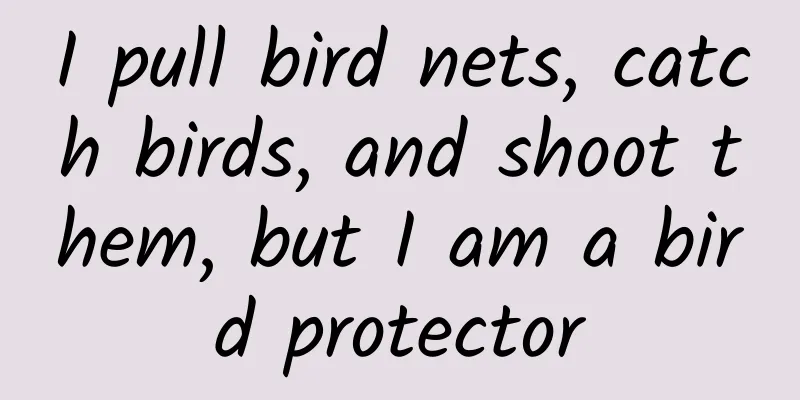I pull bird nets, catch birds, and shoot them, but I am a bird protector

|
Editor’s Note: After the last "Meeting Birds" story collection activity, we received a special letter. The author is a bird-scaring worker at Xinjiang Yining Airport. His daily job is to drive away birds near the airport to ensure aviation safety. It sounds like a job that is "enemy" to birds, but he told us that bird-scaring is not about driving away, intimidating or harming birds, but about creating a safe and harmonious blue sky for birds and airplanes. It's a truly schizophrenic profession, and such a split was inevitable from the start. Before becoming an airport bird scarer, I majored in wildlife protection, and my graduation thesis was about bird protection. After joining the company, although I deal with birds every day, everything seems to be turned upside down - the focus of my work is no longer protecting birds, but driving, catching, and even "aiming" them with guns. Bird chaser Birds should fly freely in the blue sky, but there is one exception: airports. Huge airplanes are afraid of being hit by small birds because they fly very fast. A collision with a small bird is like being hit by a small cannonball, which is very dangerous. If it hits a critical structure, it is very likely that the plane will be destroyed and people will die on the spot. In addition, when the aircraft engine is working, it needs to inhale a lot of air. If a small bird is sucked in, it may cause a malfunction, and the consequences will be very serious. F16 fighter jet struck by a bird | Wikimedia Commons According to statistics, accident symptoms caused by bird strikes on aircraft (that is, incidents that do not constitute accidents but affect or may affect safety) account for the highest proportion of all types of accident symptoms in civil aviation. Of course, birds are also afraid of airplanes. However, compared with their millions of years of evolution, airplanes are still a new thing, and many birds have not yet learned how to avoid airplanes. And the consequences of a collision are tragic - these unfortunate birds often pay the price with their lives. The moment a bird hits a Boeing 747 taking off | Aileron Aviation Films / youtube Therefore, whether it is to protect the lives of passengers and crew members, or to prevent birds that stray into the airport from being killed by collision, birds must be driven away during the take-off and landing phases of the aircraft - the profession of airport bird scarer was born. Eighteen Martial Arts of Driving Birds Away Simply put, the job of a bird scarer is to drive away birds over the airport to prevent them from colliding with airplanes. There are many ways to drive away birds, such as playing various sounds, such as the screams of birds, the sounds of natural enemies, ultrasonic bird-repelling sounds, setting off firecrackers, and beating gongs and drums. The louder the noise, the better the bird-repelling effect. Some airports place simulated people, bird-repelling flags, wind-driven bird-repelling devices, bird-repelling kites, and laser bird-repelling devices at the airport. Some airports also train sheepdogs and falcons to drive away birds, and even monkeys to dig out bird nests. All kinds of weird tricks can be thought of. Bird-scaring falcons trained at Yining Airport | Birds fly into the forest Of course, the most ruthless ones are bird-scaring guns and bird-scaring cannons, which can be considered heavy equipment and are very disturbing to people. However, these devices are only used to scare birds and will not actually hit them. In recent years, there are more and more ways to drive away birds from an ecological perspective. This is exactly the opposite of what I learned in school: "How to create a good living environment for birds." We need to transform the green space near the airport into the most unsuitable habitat for birds. For example, fill in ponds on the grass that attract birds; remove plants that feed on birds; plow the land and plant plants that do not attract birds. There are 1,000 mu of lavender fields planted at Yining Airport, where I work. Lavender is rich in camphor, linalool, linalyl and other ingredients, which can effectively repel insects and rodents and reduce the food source of birds. Lavender is also widely grown in Yili, Xinjiang | gaogaooo / Flickr The plant itself is not attractive to birds and is more competitive, effectively inhibiting the growth of bird food plants. Lavender flowers can also bring economic benefits. When lavender blooms in June, the fragrance is overwhelming, and the sight of airliners taking off from the purple land is also a unique sight. Lavender fields at Yining Airport | Meng Jin/caacnews "Bird Net" For bird strike prevention, there is another type of equipment that makes no noise, standing there silently, guarding the safety of every flight. This is the bird net. Using sound to drive birds away only scares them for a moment, and after the birds find that the threat does not seem to be that serious, they may come back; but the experience of being entangled in bird nets may make the birds realize that the airport is indeed a dangerous place. The long-eared owl caught in the bird net looks terrified | Birds fly to different forests Bird nets have another great advantage - they are quiet and do not disturb people. Therefore, they are a must-have bird-repellent "artifact" for almost all airports, and are the only bird-repellent equipment that has relevant regulations from the Civil Aviation Administration. However, for birds, quiet bird nets are the most difficult to deal with, and even fatal. The bird net is a thin layer, and it is difficult for fast-flying birds to detect and avoid it. Once they hit the net, the thin mesh will entangle their wings, claws and beaks. The more they struggle, the tighter and more complicated the entanglement becomes. No matter how high its flying skills are or how fast it is, whether it is a raptor or a small bird, a national key protected animal, or a chirping ordinary sparrow, it will be helpless when it encounters a bird net. The "bird net" is vast and not leaky. Birds entangled in the bird net can only wait for death in agony. Golden-rimmed plover entangled in the airport bird net | Birds fly to different forests But there are exceptions. If the bird is entangled in the bird net at Yining Airport, the situation may not be so bad. Although we are called "bird chasers" and we do everything we can to drive away birds every day, fundamentally speaking, our original intention is to ensure the safety of both people and birds. Therefore, my colleagues and I have to patrol and check the bird nets over and over again every day, for fear of missing any aerial elves that need to be rescued. Bird repellent rescue routine Being able to rescue a bird with your own hands and watching it fly into the blue sky is a beautiful memory that will be remembered for a long time. For airport bird scarers, rescuing birds happens every day. We rescue 3 to 5 birds every day, and up to 20 birds at most, mostly birds of prey. Once, we saw a slightly larger bird hanging on the net from a distance, so we ran over quickly. We saw a pair of large orange eyes looking at us in fear, with a hooked beak and sharp claws showing its power - it was a sparrowhawk (Accipiter nisus), a national second-class protected animal. Its flight feathers and tail feathers were tightly entangled in the net, and it took some effort to rescue it. The sparrowhawk is a medium-sized bird of prey found across much of my country | Meneer Zjeroen / Wikimedia Commons I carefully untied the web on it, just like threading a needle. But the little guy obviously didn't know that we were here to rescue it, and its instinctive fear of humans made it fight to the death with my hand. Unfortunately, I didn't wear gloves... Although this sparrow hawk was only slightly larger than the palm of my hand, its claws were not vegetarian. They pierced into my flesh like a needle, and severe pain immediately spread to the back of my hand. However, it is our duty to rescue it, so I endured the pain and continued to untie the network cable with both hands. Finally, it was successfully rescued. Saving a Sparrowhawk with Bare Hands | Each Bird Flies to Its Own Forest The sparrowhawk was in good condition, so after get off work, I took my children to release it. As soon as we let go, it immediately flapped its wings and flew high, and gradually disappeared from our sight against the backdrop of the snow-capped mountains in the distance. The child said "goodbye" to this cute little guy, but I still couldn't completely let go. The rescued birds may still mistakenly fly into the airport again after being released, causing undesirable consequences. Therefore, we usually choose to release them away from the airport runway, so that the probability of them flying back to the airport again is lower. So how do we know if the released birds have returned to the airport? The answer is bird banding. We will put a band on each released bird, just like giving them a ring with a specific number on it. Researchers banding small birds | USFWS / Wikimedia Commons For birds that stray into the airport and get entangled in bird nets, if they have rings on their feet, we can check their information to know whether it is a little fellow who has been here before and did not learn his lesson this time. Fortunately, such cases are relatively rare at present. After reading the species calendar "How is the bird I released back into the blue sky now?", I am sincerely relieved to see that more and more people are beginning to care about and protect birds. As a bird scarer, it is indeed a bit hard and boring to simply drive away birds according to regulations. But once you have a goal, such as rescuing more birds, the job of a bird scarer is still very fulfilling. I am also satisfied that the trapped birds can fly back into the blue sky and passengers can take off and land safely. Note: The long-eared owl in the title picture looks cute, but it is actually in a state of panic. Fortunately, in the end, this long-eared owl and the golden plover in the accompanying picture were successfully released by the author. Author: Birds fly into the forest Editor: Jianer This article comes from the Species Calendar, welcome to forward If you need to reprint, please contact [email protected] |
>>: "Lu Xun withdraws from Chinese textbooks"?
Recommend
Product operation and promotion: How to compete for traffic?
Recently, more and more people around me are talk...
10 pictures tell you the correct way for traditional enterprises to embrace the Internet
Embracing the Internet is the general trend Inter...
[Case] Marketing node in June, don’t blame me for not reminding you!
June 1, 719 is Yang Guifei’s birthday . Things to...
Implementing the animation effect of flipping cards
In Android design, card elements are often used, ...
The latest handling technology video replacement, Chen Jiahui's same internal recording, easily passed the handling test and easily became popular
The latest handling technology video replacement,...
China Automobile Dealers Association: Analysis of China's imported automobile market in April 2022
(I) Supply: After three years of decline, automob...
Birthday wishes video recording for African mercenaries, black mercenaries wish you a happy new year!
The annual Arbor Day is here again. On this speci...
The 120,000 yuan Camry put Toyota on the hot search, but pulled Japanese cars off the altar
Every manufacturer wants to be on the hot search....
CCTV and Jiangsu Consumer Protection Committee pointed out the problem of pop-up windows in PC software: 360 browser popped up 9 ads in 15 minutes
After the Ministry of Industry and Information Te...
How to operate and promote industrial Internet products?
The operation of industrial Internet products is ...
Mercedes-Benz: Mercedes-Benz global sales in Q4 2023 were 514,000 units, with annual cumulative sales reaching 2,043,800 units
According to media reports, Mercedes-Benz recentl...
China's CPI rose 2.5% year-on-year in June. What is the CPI index in June 2020?
In June 2020, the national consumer price index r...
One picture, write Durex-style hot copy
“The hotspot is here again!” If you remain indiff...
10 programming habits that are harmful to your development projects
Avoiding these common coding habits will make our...
Heavy rainfall hits the south again today! How to prevent floods and avoid risks scientifically?
Today, heavy rainfall in the south hit again. The...









